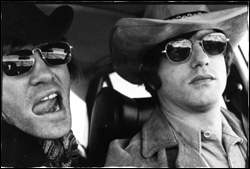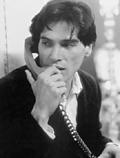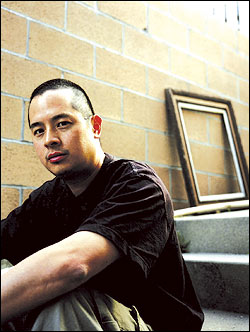The two statements that jump out of Dig! (Egyptian, 9 p.m. Sat., May 22), Ondi Timoner’s excellent new documentary about the mid-to-late-’90s trajectory of rock bands the Brian Jonestown Massacre, from Los Angeles, and Portland’s Dandy Warhols, frame the movie’s story almost too neatly. Early on, Anton Newcombe, the Massacre’s charismatic singer/songwriter/guitarist/multi-instrumentalist, says of both bands, “We’ve got a full-scale revolution going on.” By itself, it seems harmless enough—a simple moment of hubris from an artist brimming with confidence in his abilities, captured forever on celluloid.
The second significant declaration later comes from Newcombe’s sometime bandmate, Miranda Lee Richards, speaking about rock groups of bygone eras: “All those ’60s bands who used drugs got famous first.” Newcombe’s revolution turns out to be the sad repetition of an old rock-star trajectory.
You don’t have to be a music geek to dig Dig!, which shows both bands struggling to figure out how to make their retro-fitted obsessions into a career for themselves. While the Massacre faithfully recapitulate earlier eras (chiefly those of the Stones, the Beach Boys, and Buffalo Springfield), the Warhols bring a more overtly jokey manner and a lot more sheen to their tributes. Warhols leader Courtney Taylor, who also narrates the movie, is Newcombe’s temperamental opposite. When the nonchalantly careerist Warhols get busted in Paris, it’s for pot, and they’re not only let go, they keep their weed. (Vive la France!) When the would-be bad boys of the Massacre are pulled over in Georgia on their first national tour, Newcombe is arrested for heroin possession. Remember: By the ’70s, Keith Richards could afford top-dollar lawyers and doctors to cope with such inconveniences; and as Miranda Lee Richards reminds us, Newcombe never could.
As it turns out, Newcombe wasn’t the only person who got in trouble during that Georgia bust. “I was arrested, too,” says Timoner over the phone from an L.A. hotel; she was riding shotgun and filming an interview with Newcombe when the police approached. “All I could do was film. The movie is cut like we were all pulled over together, but it was just me and Anton that got pulled over. He had some warrant out . . . and no license. I had to stash the tapes and the camera in the car for my brother to pick them up, [and then] I had to hire two lawyers—one to represent me to pay my fine in Georgia, because I didn’t want to go back there; and another to make sure the cops didn’t demagnetize the tapes, because they were private property.”
Timoner began the project in 1995, as another documentary she was making about women in prison began to fizzle. “[That movie] was already getting messed up and Hollywoodized.” Told about the Massacre, she continues, “I’m a musician, and my friends are musicians, so I took a camera to film them. . . . They were totally into it. They struck me as a band that would make it on their own terms or not at all. They were not trying to figure out what the industry wanted. Two weeks later, they came to [L.A.’s] Viper Room, and they ended up in this fight pileup by the fifth song.”
Newcombe introduced Timoner to the Warhols. As Dig! makes clear, the two bands considered each other kin at first, with the Massacre the models for the Warhols’ music and image. What’s also clear is that Newcombe was so “pure” that he was unable to prevent himself from self-destructing—and so stubborn he wouldn’t allow anyone to stop him, either. During the course of the movie, he fistfights with several bandmates, kicks an audience member in the head, gets strung out on heroin, and gets the band banned from several venues—the primary reason they moved from S.F. to L.A.
Dig!‘s drama comes from Newcombe’s gradually unhinging, partly from envy at the Warhols’ success (thanks largely to a fluke European hit), and partly from his worsening heroin problem. “I was really emotionally involved,” says Timoner, who grew close with Newcombe during the long course of shooting. “It was hard for me as a filmmaker to film this guy I know destroy himself at this really crucial moment of his career.”
The singer has since cleaned up, but it doesn’t seem coincidental that, according to Timoner, the Massacre have gone through over 50 members since the original’s dissolution. “I don’t really spend time with Anton now,” says Timoner. “I called him to tell him the film got into Sundance, and he started railing at me because I missed his band’s show. I was like, ‘I just had my son a month ago. You’re going to have to have someone else film your band.'” And maybe go to jail in the process. But that’s a different movie.








